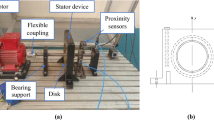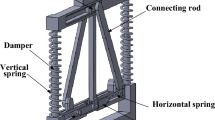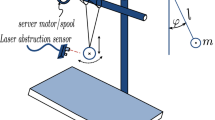Abstract
This paper deals with friction-induced vibration of a disc brake system with a constant friction coefficient. A linear, lumped, and distributed parameter model to represent the floating caliper disc brake system is proposed. The complex eigenvalues are used to investigate the dynamic stability, and, in order to verify simulations which are based on the theoretical model, an experimental modal test and dynamometer test are performed. The comparison of experimental and theoretical results shows good agreement, and the analysis indicates that modal coupling due to friction forces is responsible for disc brake squeal. Also, squeal type instability is investigated, using a parametric analysis. This indicates which parameters have influence on the propensity of brake squealing. This is helpful for validating the analysis model and establishing confidence in the experimental results of the modified system. These results may also be useful during system development or diagnostic analysis.
Similar content being viewed by others
References
Brooks, P. C., Crolla, D. A., Lang, A. M. and Schafer, D. R. (1993). Eigenvalue sensitivity analysis applied to disc brake squeal. Proc. IMechE, C444/004, 135–143.
Chen, J. S. and Bogy, D. B. (1992). Effects of load parameters on the natural frequencies and stability of a flexible spinning disk with a stationary load system. Trans. ASME, J. Applied Mechanics, 59, 230–235.
Crolla, D. A. and Lang, A. M. (1990). Brake noise and vibration — The state of the art. Proc. 17th Leeds, Lyon Symp. Tribology, The University of Leeds, UK, 165–174.
Cunefare, K. A. and Ryan, R. (2001). Investigation of disc squeal via sound intensity and laser vibrometry. SAE Paper No. 2002-01-1604.
Earles, S. W. E. and Chambers, P. W. (1987). Disc brake squeal noise generation: Predicting its dependency on system parameters including damping. Int. J. Vehicle Design 8,4/5/6, 538–552.
Earles, S. W. E. and Chambers, P. W. (1988). Disc brake squeal — Some factors which influence its occurrence. Proc. IMechE, C454/88, 39–46.
Fieldhouse, J. D. and Newcomb, T. P. (1993). An experimental investigation into disc brake noise. Proc. IMechE, C444/036, 145–159.
Jarvis, R. P. and Mills, B. (1964). Vibrations induced by dry friction. Proc. IMechE, C178/32, 847–866.
Lamb, H. and Southwell, R. V. (1921). The vibrations of a spinning disk. Proc. Royal Soc., London, 99, 272–280.
Matsui, H., Murakami, H., Nakanishi, H. and Tsuda, Y. (1992). Analysis of disc brake squeal. SAE Paper No. 920553, 15–24.
Mottershead, J. E. and Chan, S. N. (1995). Flutter instability of circular discs with frictional follower loads. J. Vibration and Acoustics, 117, 161–163.
Nosseir, T. A., Said, M. A. R., EL Nahas, N. S. and El Fetouh, G. Abu, (1998). Significance of squeal in disc brake design. Int. J. Vehicle Design, 19/1, 124–133.
Ouyang, H. and Mottershead, J. E. (2001). Unstable traveling waves in the friction-induced vibration of discs. J. Sound and Vibration, 248, 768–779.
Ouyang, H., Mottershead, J. E., Cartmell, M. P. and Friswell, M. I. (1998). Friction-induced parametric resonances in discs: effect of a negative friction-velocity relationship. J. Sound and Vibration, 209, 251–264.
Shin, K., Brennan, M. J., Joe, Y.-G. and Oh, J.-E. (2004). Simple mode1s to investigate the effect of velocity dependent friction on the disk brake squeal noise. Int. J. Automotive Technology 5,1, 61–67.
Stanbridge, A. B. and Ewins, D. J. (1996). Using a continuously-scanning laser doppler vibrometer for modal testing. Proc. IMAC, 14th Int. Modal Analysis Conf., 816–822.
Author information
Authors and Affiliations
Corresponding author
Rights and permissions
About this article
Cite this article
Joe, Y.G., Cha, B.G., Sim, H.J. et al. Analysis of disc brake instability due to friction-induced vibration using a distributed parameter model. Int.J Automot. Technol. 9, 161–171 (2008). https://doi.org/10.1007/s12239-008-0021-x
Received:
Revised:
Published:
Issue Date:
DOI: https://doi.org/10.1007/s12239-008-0021-x




